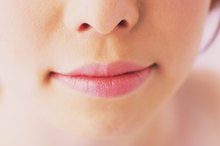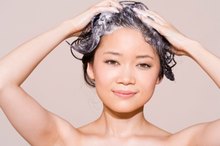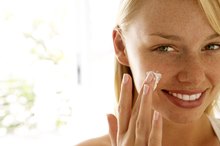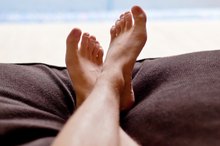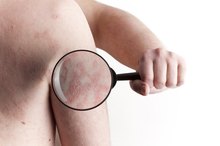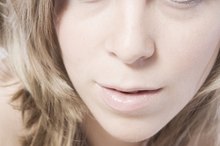What does fact checked mean?
At Healthfully, we strive to deliver objective content that is accurate and up-to-date. Our team periodically reviews articles in order to ensure content quality. The sources cited below consist of evidence from peer-reviewed journals, prominent medical organizations, academic associations, and government data.
The information contained on this site is for informational purposes only, and should not be used as a substitute for the advice of a professional health care provider. Please check with the appropriate physician regarding health questions and concerns. Although we strive to deliver accurate and up-to-date information, no guarantee to that effect is made.
Dry Skin on the Lower Back
Dry skin on the lower back can be itchy, uncomfortable and frustrating. This skin issue can be caused by a variety of factors, including allergic reaction, irritating chemicals or skin underlying conditions. Learning what causes flareups and partnering with your physician will assist in clearing up dry lower back skin. You can also take steps to minimize this problem in the future.
Causes
Dry skin on the back can be caused by many things. For example, if the lower back experiences friction often, it can result in thickening skin and dryness. Sun exposure can also contribute to developing dry lower back skin. Using irritating laundry detergents and taking hot showers may also be to blame. Sometimes, there is an underlying health condition, such as psoriasis.
- Dry skin on the back can be caused by many things.
- For example, if the lower back experiences friction often, it can result in thickening skin and dryness.
Treatments
Itchy Skin on the Nose
Learn More
Treat dry skin on the lower back by taking a warm bath with oatmeal. Use an unscented moisturizer after your bath on the affected area. If the area is scaly, use a nonprescription cream that contains lactic acid and urea, recommends MayoClinic.com 1. Continue this process until the skin’s appearance has improved. If the dry skin cracks open, apply a wet dressing to the lower back to prevent infection. Your doctor might also recommend applying a hydrocortisone cream to the skin.
- Treat dry skin on the lower back by taking a warm bath with oatmeal.
- Use an unscented moisturizer after your bath on the affected area.
Considerations
Decrease dryness by purchasing clothes made of natural fibers. Cotton and silk allow the skin the breath easier and don’t irritate the skin. Avoid fabrics that cause irritation, such as wool. Also, consider using a humidifier if you live in a dry climate. Dry air can make sensitive skin worse, according to MayoClinic.com 1. Change the water in the humidifier daily to prevent bacteria growth.
- Decrease dryness by purchasing clothes made of natural fibers.
- Dry air can make sensitive skin worse, according to MayoClinic.com 1.
Misconceptions
Crusty Spots on the Scalp
Learn More
Some people don’t consult a doctor about lower back skin dryness. However, dry skin on the back could be a sign of an underlying health condition. For example, lower back skin that is red, cracked and inflamed may be a symptom of eczema. Consult your doctor to rule out an underlying health issue for lower back skin dryness.
- Some people don’t consult a doctor about lower back skin dryness.
- Consult your doctor to rule out an underlying health issue for lower back skin dryness.
Warnings
Although anyone can develop lower back skin dryness, it is more common in dry or cold climates, according to MayoClinic.com 1. People who bathe frequently are also at higher risk. Use an SPF of 30 or higher on the body, including the back, to prevent skin dryness from sun exposure, recommends the American Academy of Dermatology 2. Even if the weather is cloudy, wear sunscreen to protect yourself from harmful rays.
Related Articles
References
- MayoClinic.com: Dry Skin
- American Academy of Dermatology: Winter Skin Care Guidelines
- Medline Plus: Itching
- Harvard Medical School Harvard Health Publishing. 9 ways to banish dry skin.
- Farage MA, Miller KW, Elsner P, Maibach HI. Characteristics of the aging skin. Advances in Wound Care. 2013;2(1):5-10. doi:10.1089/wound.2011.0356
- Engebretsen K, Johansen J, Kezic S, Linneberg A, Thyssen J. The effect of environmental humidity and temperature on skin barrier function and dermatitis. J Eur Acad Dermatol and Venereol. 2016;30(2):223-249. doi:10.1111/jdv.13301
- Goad N, Gawkrodger D. Ambient humidity and the skin: the impact of air humidity in healthy and diseased states. J Eur Acad Dermatol and Venereol. 2016;30(8):1285-1294. doi:10.1111/jdv.13707
- Flament F, Bazin R, Rubert , Simonpietri , Piot B, Laquieze. Effect of the sun on visible clinical signs of aging in Caucasian skin. CCID. 2013;6: 221–232. doi:10.2147/CCID.S44686
- Penn Medicine. The winter itch: what causes dry skin, and what you can do about it. Updated January 30, 2017.
- U.S. Pharmacist. Causes and treatment of dry skin. Updated April 23, 2012.
- Griffiths CEM, van de Kerkhof P, Czarnecka-Operacz M. Psoriasis and atopic dermatitis. Dermatol Ther (Heidelb). 2017;7(S1):31-41. doi:10.1007/s13555-016-0167-9
- Combs SA, Teixeira JP, Germain MJ. Pruritus in kidney disease. Seminars in Nephrology. 2015;35(4):383-391. doi:10.1016/j.semnephrol.2015.06.009
Writer Bio
Nicki Howell started her professional writing career in 2002, specializing in areas such as health, fitness and personal finance. She has been published at health care websites, such as HealthTree, and is a ghostwriter for a variety of small health care organizations. She earned a Bachelor of Science in business administration from Portland State University.
